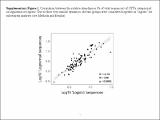Por favor, use este identificador para citar o enlazar a este item:
http://hdl.handle.net/10261/184837COMPARTIR / EXPORTAR:
 SHARE SHARE
 CORE
BASE CORE
BASE
|
|
| Visualizar otros formatos: MARC | Dublin Core | RDF | ORE | MODS | METS | DIDL | DATACITE | |

| Título: | Higher contribution of globally rare bacterial taxa reflects environmental transitions across the surface ocean |
Autor: | Ruiz-González, Clara CSIC ORCID ; Logares, Ramiro CSIC ORCID ; Sebastián, Marta CSIC ORCID; Mestre, Mireia CSIC ORCID; Rodríguez-Martínez, Raquel CSIC ORCID; Galí, Martí CSIC ORCID; Sala, M. Montserrat CSIC ORCID ; Acinas, Silvia G. CSIC ORCID ; Duarte, Carlos M. CSIC ORCID; Gasol, Josep M. CSIC ORCID | Palabras clave: | Dispersal Rare bacteria Marine prokaryotic communities Malaspina expedition Global surface ocean Spatial abundance distribution Environmental transitions |
Fecha de publicación: | abr-2019 | Editor: | Wiley-Blackwell | Citación: | Molecular Ecology 28(8): 1930-1945 (2019) | Resumen: | Microbial taxa range from being ubiquitous and abundant across space to extremely rare and endemic, depending on their ecophysiology and on different processes acting locally or regionally. However, little is known about how cosmopolitan or rare taxa combine to constitute communities and whether environmental variations promote changes in their relative abundances. Here we identified the Spatial Abundance Distribution (SpAD) of individual prokaryotic taxa (16S rDNA-defined Operational Taxonomic Units, OTUs) across 108 globally-distributed surface ocean stations. We grouped taxa based on their SpAD shape (“normal-like”- abundant and ubiquitous; “logistic”- globally rare, present in few sites; and “bimodal”- abundant only in certain oceanic regions), and investigated how the abundance of these three categories relates to environmental gradients. Most surface assemblages were numerically dominated by a few cosmopolitan “normal-like” OTUs, yet there was a gradual shift towards assemblages dominated by “logistic” taxa in specific areas with productivity and temperature differing the most from the average conditions in the sampled stations. When we performed the SpAD categorization including additional habitats (deeper layers and particles of varying sizes), the SpAD of many OTUs changed towards fewer “normal-like” shapes, and OTUs categorized as globally rare in the surface ocean became abundant. This suggests that understanding the mechanisms behind microbial rarity and dominance requires expanding the context of study beyond local communities and single habitats. We show that marine bacterial communities comprise taxa displaying a continuum of SpADs, and that variations in their abundances can be linked to habitat transitions or barriers that delimit the distribution of community members | Descripción: | 16 pages, 6 figures, 1 table, supporting information https://dx.doi.org/10.1111/mec.15026 | Versión del editor: | https://dx.doi.org/10.1111/mec.15026 | URI: | http://hdl.handle.net/10261/184837 | DOI: | 10.1111/mec.15026 | Identificadores: | doi: 10.1111/mec.15026 issn: 0962-1083 e-issn: 1365-294X |
| Aparece en las colecciones: | (ICM) Artículos |
Ficheros en este ítem:
| Fichero | Descripción | Tamaño | Formato | |
|---|---|---|---|---|
| Ruiz_Gonzalez_et_al_2019_postprint.pdf | 5,22 MB | Adobe PDF |  Visualizar/Abrir | |
| Ruiz_Gonzalez_et_al_2019_suppl.pdf | 1,34 MB | Adobe PDF |  Visualizar/Abrir |
CORE Recommender
SCOPUSTM
Citations
23
checked on 20-abr-2024
WEB OF SCIENCETM
Citations
23
checked on 27-feb-2024
Page view(s)
233
checked on 19-abr-2024
Download(s)
219
checked on 19-abr-2024
Google ScholarTM
Check
Altmetric
Altmetric
NOTA: Los ítems de Digital.CSIC están protegidos por copyright, con todos los derechos reservados, a menos que se indique lo contrario.
